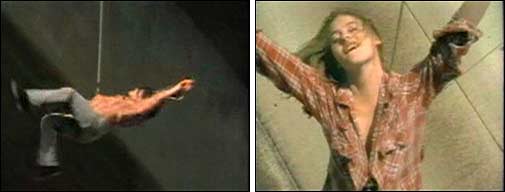Aerosmith
The release — and subsequent winning of MTV's "1994 Best Music Video of the Year" award — of Aerosmith's Cryin' is widely regarded as the moment when body piercing became mainstream. It was the first time body piercing was presented in a mainstream medium in a relatively positive context, and it was the first time many people had really seen body piercing up close. As a result, millions of people went out and got body piercings after seeing the video. It was also the first time that youth culture began getting told by their "authority figures" that body piercing was cool, and if they knew what was good for them, they'd go get one NOW!
One BME experience that typifies the video's effect reads:
- It started when I was 16. Actually, that's not quite true. It started whenever I first saw the video for Aerosmith's "Cryin'" on MTV. From the moment I saw Alicia Silverstone's character get her bellybutton pierced, I knew I wanted one. But I also knew I would never get one. That was something rebels did; I could never be that cool. Come on, I was like 12, what do you expect? Anyway, when I turned sixteen, I slowly began to realize that my dream could potentially become a reality. So, my best friend Diana and I decided to do it. We were going to get our bellybuttons pierced.
Directed by Marty Callner and starring Alicia Silverstone (and a young Paul King as her body piercer), the video begins with a foreshadowing of her suicide by leaping from an overpass. We see her troubled relationship with her boyfriend, and then watch as she's first tattooed...
... and then her navel is pierced, featuring close-up footage of a 100% real piercing (the piercing is not actually on Alicia though; she considered the whole thing to be "disgusting" at the time) ...
After a bit of wildness and teenage angst, we return to Alicia on the bridge, ready to leap. The boyfriend she's left behind, along with the police, plead with her not to jump, but they can't stop her, and with a smile, she appears to begin the plunge to her death.
In what one could also argue (stretching things a bit) is the first mainstream public showing of a suspension, it turns out Alicia had a rope attached to her navel ring, and at the end of the video, she could, like so many of us, say with total honesty, "body piercing saved my life."
During 1993 and 1994 when these videos were released, body piercing moved from being an underground phenomenon to a massive youth movement, and then on to being a cross-demographic mega-phenomenon. New studios were opening daily, and people started saying "When I grow up, I want to be a body piercer." Macaulay Culkin even had a movie in the works where he starred as a body piercer, though the project was later scrapped. Do we owe it all to Aerosmith and their somewhat exploitative videos?



